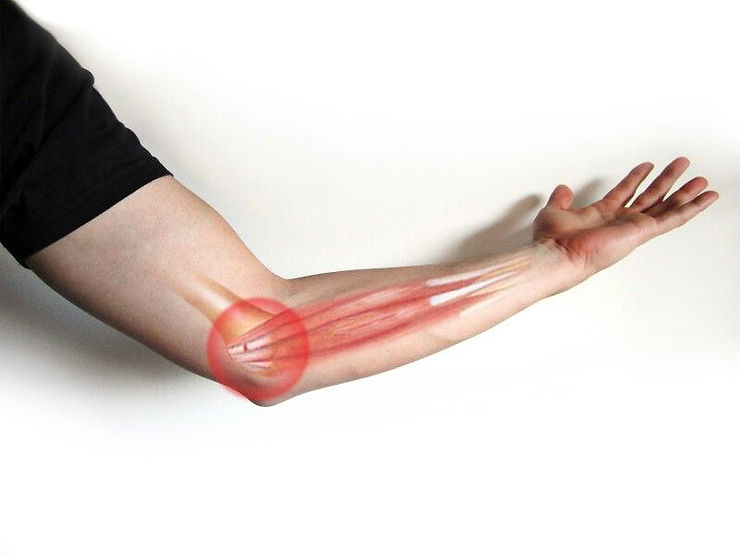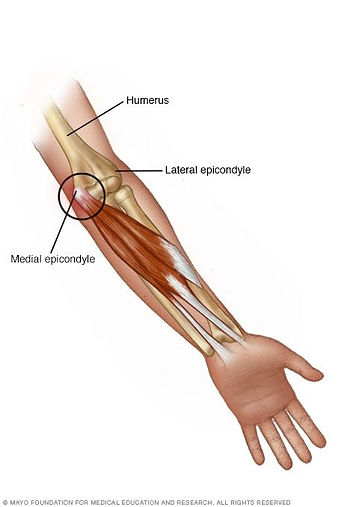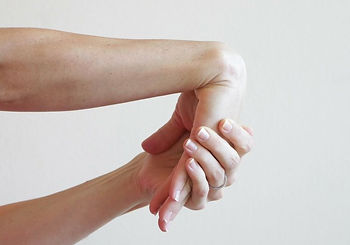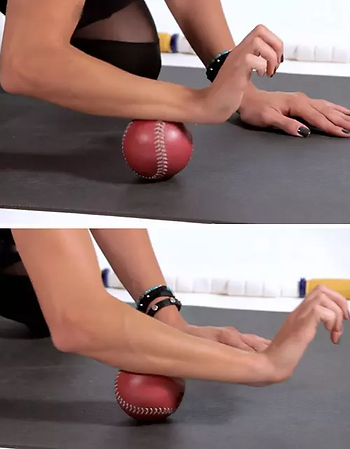DynamicRecov's Blog
An educational blog where you can elevate your knowledge on health and fitness, gain knowledge when deciding if personal training is right for you and get the latest tips on how to maximise your performace.

Golfers Elbow Exercises: Strengthening Your Way to a Pain-Free Swing
Golfers Elbow Exercises: Strengthening Your Way to a Pain-Free Swing

Discover effective exercises to alleviate and prevent golfers elbow, a common condition among golfers. Strengthen your forearm muscles and improve your game with these targeted exercises.
Introduction
Golf is a beloved sport enjoyed by millions around the world, offering a unique combination of physical activity and mental focus. However, avid golfers often face a frustrating obstacle known as golfer's elbow. Also referred to as medial epicondylitis, golfer's elbow manifests as pain and tenderness on the inside of the elbow. The good news is that there are targeted exercises available to incorporate into your fitness routine, providing relief from discomfort and helping you regain your swing.
In this comprehensive blog post, we will delve into the realm of golfer's elbow exercises, equipping you with the knowledge and techniques to alleviate this condition and enhance your golf performance. Get ready to strengthen your way to a pain-free swing!
What is Golfer's Elbow?

Golfer's elbow, medically known as medial epicondylitis, is a condition characterised by inflammation and pain in the tendons that connect the forearm muscles to the bony bump on the inside of the elbow. Despite its name, golfer's elbow can affect not only golfers but also individuals who engage in repetitive gripping or wrist movements, such as tennis players, weightlifters, and painters.
The primary cause of golfer's elbow is the repetitive stress and overuse of the forearm muscles, leading to tiny tears in the tendons. This can result from activities involving gripping, swinging, or flexing of the wrist. Common symptoms include pain and tenderness on the inner side of the elbow, weak grip strength, and discomfort when flexing or rotating the forearm.
Managing golfer's elbow involves a multifaceted approach, and exercise plays a crucial role in its treatment and prevention. By understanding the causes and symptoms of this condition, you can take proactive steps to alleviate pain, promote healing, and enhance your overall arm strength and flexibility. Let's explore some effective golfer's elbow exercises that can help you on your journey to recovery and improved performance on the golf course.
Importance of Exercise for Golfer's Elbow
Exercise is a key component in the management of golfer's elbow. It serves multiple purposes, including strengthening the affected muscles, improving flexibility, promoting blood flow to the injured area, and enhancing overall joint stability. By engaging in targeted exercises, you can alleviate pain, reduce inflammation, and prevent future occurrences of golfer's elbow.
Regular exercise helps to strengthen the forearm muscles, which are crucial for maintaining a stable and controlled grip during golf swings and other repetitive activities. Strong forearm muscles provide better support to the tendons, reducing the strain on the elbow joint. Additionally, exercise stimulates the production of collagen, a protein essential for tendon health and repair.
Incorporating specific exercises into your fitness routine can also improve flexibility in the forearm muscles and tendons. Increased flexibility allows for a wider range of motion and reduces the likelihood of excessive stress on the tendons during activities that involve gripping or wrist movements. Moreover, exercise helps to promote blood circulation to the injured area, supplying vital nutrients and oxygen to the tissues, which aids in the healing process.
Furthermore, regular exercise for golfer's elbow serves as a preventive measure. By strengthening the forearm muscles and improving flexibility, you can reduce the risk of re-injury and protect yourself from future episodes of golfer's elbow. Consistency in exercise not only helps to alleviate current symptoms but also contributes to long-term joint health and overall fitness.
In the following sections, we will explore a variety of effective golfer's elbow exercises that target the affected muscles and promote healing. These exercises can be performed at home or in a gym setting, using minimal equipment. By incorporating these exercises into your routine, you can take a proactive approach towards managing golfer's elbow and improving your golf performance.
Golfer's Elbow Exercises
A. Wrist Flexion Stretch

The wrist flexion stretch is a simple yet effective exercise for relieving golfer's elbow pain and increasing flexibility in the forearm muscles. To perform this exercise:
Sit or stand with your arm extended in front of you, palm facing down.
Use your other hand to gently bend your wrist downward until you feel a stretch in the forearm.
Hold the stretch for 15-30 seconds, then release.
Repeat the stretch 2-3 times on each arm.
B. Forearm Pronation and Supination
Pronation and supination exercises help to strengthen the muscles in your forearm and improve their endurance. Here's how to perform this exercise:
Hold a light dumbbell or a weighted object such as a hammer or soup can.
Sit in a chair with your forearm resting on your thigh and your wrist hanging over the edge.
Slowly rotate your hand outward (supination) until your palm is facing upward.
Rotate your hand inward (pronation) until your palm is facing downward.
Perform 10-15 repetitions for each direction and gradually increase the weight as you get stronger.
C. Eccentric Wrist Extension
Eccentric wrist extension exercises specifically target the forearm muscles, providing strength and stability to the elbow joint. Follow these steps to perform the exercise:
Sit at a table with your forearm supported and your hand hanging off the edge, palm facing down.
Hold a lightweight dumbbell or a similar object in your hand.
Slowly lower the weight by bending your wrist downward.
Use your other hand to return your wrist to the starting position.
Perform 10-15 repetitions for each arm, gradually increasing the weight as your strength improves.
D. Forearm Flexor Stretch
Stretching the forearm flexor muscles can help alleviate tension and tightness associated with golfer's elbow. Follow these steps to perform the stretch:
Extend your affected arm straight in front of you, palm facing up.
Use your other hand to bend your wrist downward, so your fingers point towards the floor.
Gently pull your fingers towards your body until you feel a stretch in your forearm.
Hold the stretch for 15-30 seconds, then release.
Repeat the stretch 2-3 times on each arm.
By incorporating these exercises into your fitness routine, you can target the specific muscles involved in golfer's elbow and promote healing. Remember to start with lighter weights or minimal resistance and gradually increase the intensity as your strength and comfort levels progress. Consistency and proper form are key to achieving the best results.
Tips for Incorporating Golfer's Elbow Exercises into Your Routine

To make the most out of your golfer's elbow exercises and ensure a safe and effective workout, consider the following tips:
A. Start with lighter weights and gradually increase intensity
Begin your exercises with light dumbbells or resistance bands and gradually progress to heavier weights or increased resistance over time. This progressive approach allows your muscles and tendons to adapt and grow stronger without putting excessive strain on them from the start.
B. Emphasise proper form and technique
Correct form is crucial for maximising the benefits of golfer's elbow exercises while minimising the risk of injury. Pay close attention to your posture, grip, and movement patterns throughout each exercise. If needed, consult a fitness professional or physical therapist to ensure you are performing the exercises correctly.
C. Maintain consistency and regular exercise
Consistency is key when it comes to managing golfer's elbow. Aim for regular exercise sessions, ideally two to three times per week, to strengthen the forearm muscles and promote healing. Stick to a routine that suits your schedule and allows for adequate recovery between sessions.
D. Listen to your body
Pay attention to any discomfort or pain during or after exercising. While some muscle soreness is normal, sharp or persistent pain could be a sign of overexertion or incorrect technique. If you experience prolonged or worsening pain, it's important to seek advice from a healthcare professional.
E. Consult with a healthcare professional
If you're unsure about which exercises are suitable for your specific condition or if you have persistent pain despite incorporating exercises, it's recommended to consult with a healthcare professional such as a sports medicine physician or physical therapist. They can provide personalised guidance, assess your condition, and offer additional treatment options if necessary.
By following these tips, you can optimise the effectiveness of your golfer's elbow exercises, reduce the risk of further injury, and progress towards a pain-free swing. Remember to listen to your body, be patient with your progress, and celebrate even the smallest improvements along the way. With dedication and proper exercise, you'll be well on your path to overcoming golfer's elbow and enjoying an improved golfing experience.

Conclusion
In conclusion, golfer's elbow doesn't have to hinder your golfing experience or daily activities. By incorporating targeted exercises into your fitness routine, you can alleviate pain, improve flexibility, and strengthen the affected muscles. Through consistent and proper exercise, you have the power to manage golfer's elbow effectively and prevent its recurrence.
The exercises outlined in this blog post, such as the wrist flexion stretch, forearm pronation and supination, eccentric wrist extension, and forearm flexor stretch, are excellent choices to target the specific muscles involved in golfer's elbow. Remember to start with lighter weights or resistance and gradually progress as your strength improves.
Furthermore, it's essential to emphasise proper form and technique during your exercises to maximise their benefits while minimising the risk of injury. Pay attention to your body's signals, and if you experience persistent or worsening pain, consult with a healthcare professional.
By incorporating golfer's elbow exercises into your routine, you are taking proactive steps towards healing, preventing future injuries, and improving your golf performance. Stay consistent, listen to your body, and be patient with your progress. With time, dedication, and the right exercises, you can overcome golfer's elbow and enjoy a pain-free swing, allowing you to fully embrace the joy of golf.
So, get started on your journey to a stronger, healthier, and more enjoyable golfing experience. Swing away with confidence and conquer golfer's elbow!

